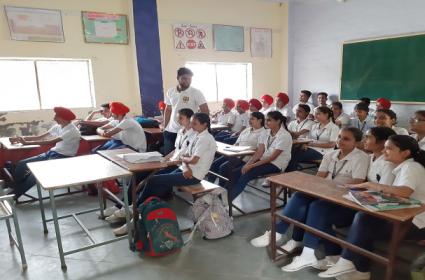Access to Quality Learning Needed to Deal with COVID-19 Impact on Education

India has the second largest education system in the world, a system that received a rude shock from the pandemic, and that is yet to recover from it as wave upon wave of Covid-19 has threatened resumption of traditional formal learning.
Through measures like the National Education Policy, 2020, India aims to change the course of education delivery and transform its education system by driving widespread access to quality education. Put simply, the aim is to nurture the most important transformations in the system so everyone can access education. This pursuit is not new. Our country has been striving to drive access to education. The Right of Children to Free and Compulsory Education Act, 2009 showcases the government's intent clearly. It is just that the National Education Policy 2020 gives us a roadmap to chase the dream of universal access to quality education.
Over the years, state governments have also been active in rolling out and implementing schemes to ensure education for all. From Tamil Nadu and Kerala to Haryana and Punjab, Uttar Pradesh, Madhya Pradesh and Maharashtra, all states have an array of schemes to ensure education access. Case in point - the Madhya Pradesh state administration oversees the implementation of schemes like the Kanya Saksharta Protsaahan Yojana, the Ladli Laxmi Yojana, the Mukhyamantri Awas Sahayata Yojana, the MP Mukhyamantri Kaushalya Yojna, and the Vimukt Jati Hostel Yojana to improve access to education and skill development.
But a lot more needs to be done. UNESCO estimates nearly 1.5 billion students across the world have been affected by the disruption caused to formal education by Covid-19. What's worse is that a joint report by UNESCO, UNICEF, World Bank, and the OECD has concluded that one in three countries are not taking action to help students catch up on their learning COVID-induced school closures.
What policymakers must also do is to work to improve the efficacy of education delivery. As per data from Annual Status of Education Report, only 16% of children in Class 1 in 26 surveyed rural districts of India can read text at the prescribed level, while almost 40% cannot even recognize letters. More than 70% Class 3 students lack basic reading and math skills, which are foundational to learning.
We must look at driving access to quality education to all children, particularly during the pandemic when so many underprivileged children have been forced out of education. The country's civil society organizations have made efforts to ensure pupils do not go off-grid. I would like to talk about one such endeavor which I have had the chance to see closely. The Shiksha Na Ruke initiative by Smile Foundation has so far educated more than 50,000 children in 22 states through the blended learning approach, which includes alternate learning mediums. Such efforts must be encouraged. India requires increased multi-stakeholder collaboration to make a profound difference.
Governments cannot be expected to drive quality education across this massive country of ours. They require assistance from others to achieve this. To be clear, there are three key pieces to the puzzle, three key stakeholders who must work in better synchrony to effect meaningful change – governments, corporates, and civil society organizations. Each of them brings unique strengths to the table. While governments have scale, corporates have funds and the ability to plan interventions to the Civil society organizations bring strong on-ground connect and experience of delivering impact on terra firma, battling challenges of diversity, lack of infrastructure, and geographical expanse.
What all the three stakeholders need to do urgently is to bridge the trust deficit and work together to design and implement targeted interventions that deliver maximum impact for the greatest number of people. India needs population scale impact in a short duration of time. It needs its three biggest stakeholders to collaborate and deliver on the promise of quality education for our children. The approaches to high-impact learning can be varied, as prescribed in the National Education Policy 2020 (NEP).
NEP duly recognizes multimodal learning and encourages the introduction of new methodologies and approaches in pedagogy. It is refreshing to see the policy emphasize learning through means like online education, and through traditional media like television and radio. The recognition of subjects like artificial intelligence and machine learning shows intuitive thinking on the part of policymakers.
What is now needed is the design and implementation of a set of high-impact interventions that can deliver population scale change on learning outcomes of students, particularly those coming from less privileged circumstances. India must aggressively chase this so the country can truly reap the fruits of its demographic dividend and emerge from the pandemic stronger.
--By Dr. Aatish Parashar, Dean & Head, Central University of South Bihar





















